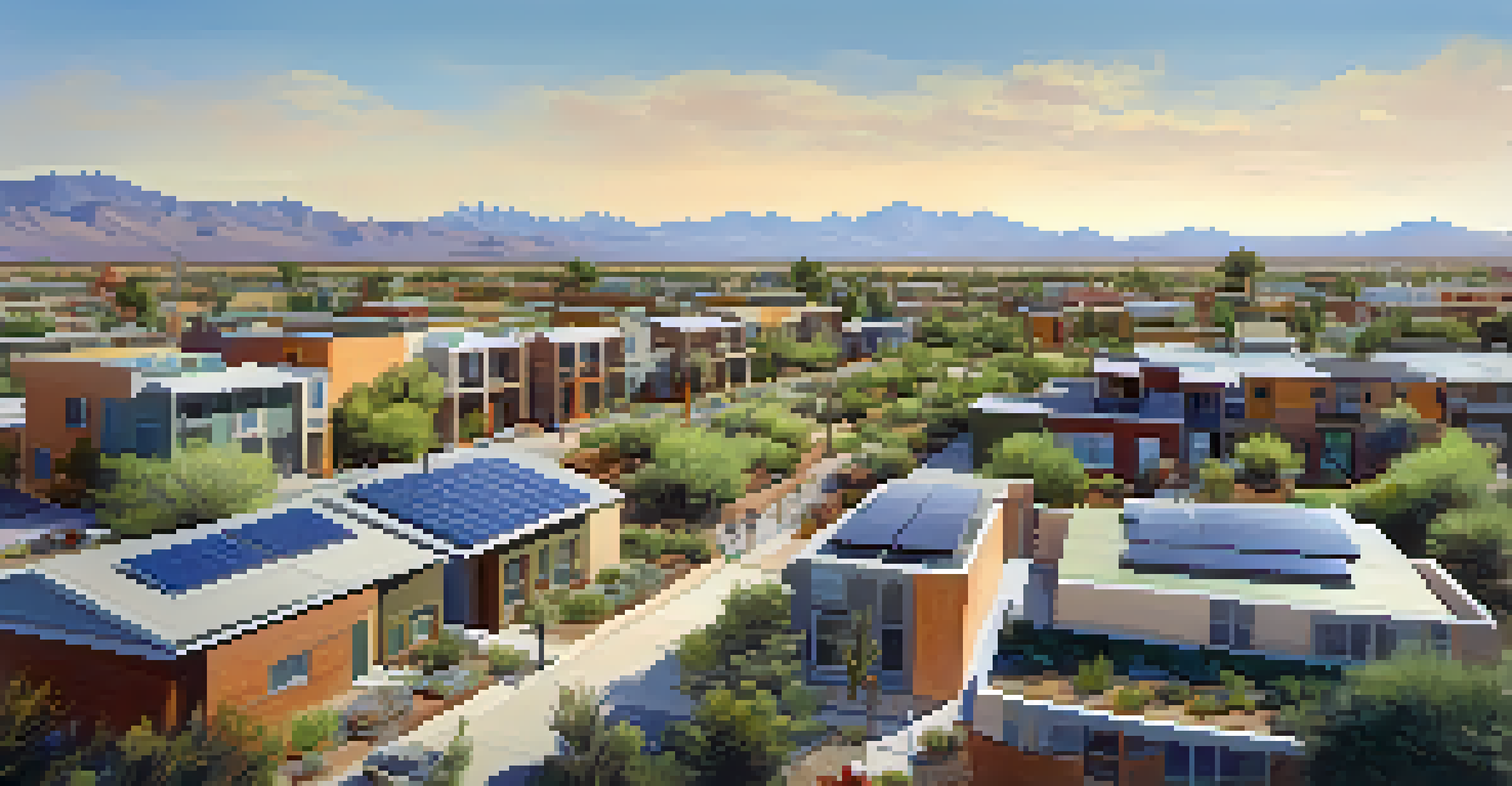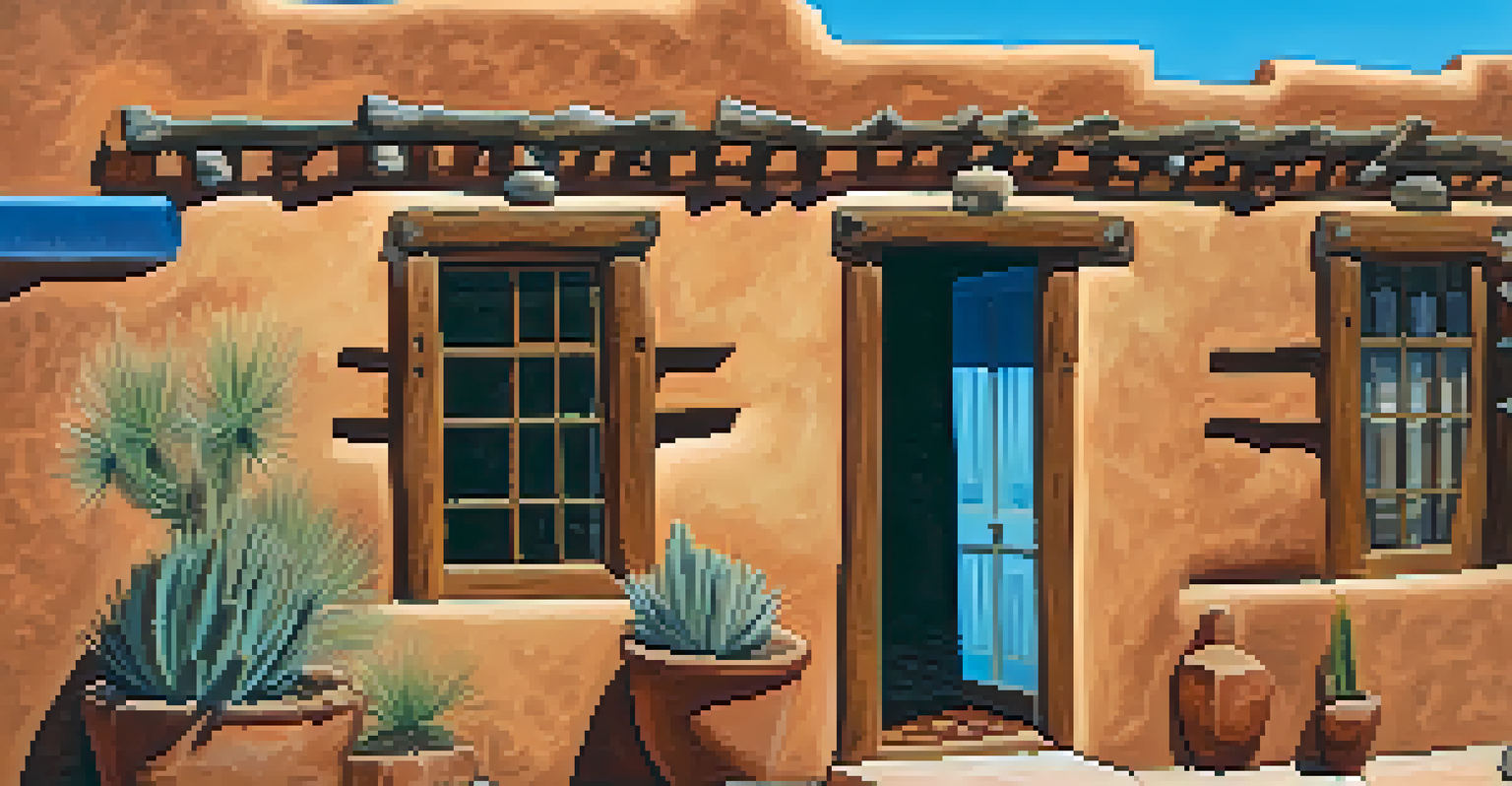The Impact of Urban Development on Arizona's Architecture

The Evolution of Arizona's Architectural Landscape
Arizona's architecture has a rich history that reflects its unique cultural heritage. From the adobe structures of Native American tribes to the Spanish colonial influences, the state's architectural evolution tells a story of adaptation and resilience. Over time, these styles have blended with modern influences, creating a diverse architectural tapestry that defines Arizona today.
Architecture should speak of its time and place, but yearn for the timeless.
As urban development accelerates, we see a shift towards contemporary designs that prioritize sustainability and efficiency. This transition often means that traditional styles are at risk of being overshadowed by new constructions that may not honor the past. Yet, the challenge lies in finding a balance between preserving historical significance and accommodating modern needs.
The interplay between old and new architecture can be seen in cities like Phoenix and Tucson, where historic buildings coexist with sleek, glass-fronted skyscrapers. This dynamic creates a visual dialogue, inviting residents and visitors alike to appreciate the layers of history embedded in urban spaces. Ultimately, understanding this evolution helps us recognize the importance of preserving Arizona's architectural heritage.
Sustainable Practices in Modern Architecture
As urban development progresses, sustainability has become a key focus in Arizona's architectural practices. Architects and developers are increasingly incorporating eco-friendly materials and energy-efficient designs to minimize environmental impact. This shift not only meets regulatory demands but also resonates with a growing population that values sustainability.

One notable example is the use of solar panels, which have become a common feature in new constructions across the state. Given Arizona's abundant sunshine, harnessing solar energy is not just practical; it's a vital step towards reducing carbon footprints. Furthermore, sustainable practices extend beyond energy efficiency to include water conservation, which is crucial in this arid region.
Cultural Heritage Shapes Architecture
Arizona's architectural identity is influenced by its diverse cultural heritage, blending Native American, Hispanic, and Anglo-American traditions.
Integrating sustainable practices into urban development does more than protect the environment; it enhances the quality of life for residents. Green roofs, parks, and community gardens foster a sense of belonging and improve mental well-being. As Arizona continues to grow, prioritizing sustainability in architecture will be essential for creating healthy, vibrant communities.
Urban Sprawl and Its Architectural Consequences
Urban sprawl refers to the spread of a city and its suburbs over more rural land, and it's a phenomenon that has significantly impacted Arizona. As cities expand, the demand for housing and infrastructure often leads to the construction of cookie-cutter developments. While these neighborhoods may provide immediate solutions for housing, they can lack character and a sense of community.
We shape our buildings; thereafter, they shape us.
The consequences of urban sprawl extend beyond aesthetics; they also affect the environment and local ecosystems. Increased car dependency leads to higher emissions, while the loss of green spaces diminishes biodiversity. Addressing these issues requires thoughtful planning that prioritizes mixed-use developments and public transportation options.
To combat the challenges of urban sprawl, Arizona is exploring innovative solutions such as infill development, which focuses on utilizing vacant lots within existing urban areas. This approach not only preserves open spaces but also revitalizes neighborhoods, encouraging a more cohesive community. By reimagining urban growth, Arizona can create vibrant spaces that respect both nature and architectural integrity.
Cultural Influences Shaping Arizona's Architecture
Arizona's architectural identity is deeply intertwined with its diverse cultural influences. The state's rich tapestry includes Native American, Hispanic, and Anglo-American traditions, each contributing unique elements to the architectural landscape. This cultural fusion is particularly evident in cities like Santa Fe, where adobe buildings reflect the region's indigenous heritage.
As urban development continues, it's essential to honor these cultural influences in new designs. Architects are increasingly seeking to incorporate local materials and traditional styles into modern constructions, creating a harmonious blend of old and new. This practice not only pays homage to the past but also enriches the architectural narrative of the present.
Sustainability Drives Modern Design
Modern architecture in Arizona increasingly prioritizes sustainability, incorporating eco-friendly materials and energy-efficient designs to enhance quality of life.
Moreover, public art installations and community spaces are often designed to reflect local culture, fostering a sense of pride among residents. By embracing the diverse influences that shape Arizona's architecture, urban development can create spaces that resonate with the community and tell a story. This cultural connection ultimately enhances the sense of place and belonging.
The Role of Technology in Urban Architecture
Technology plays a pivotal role in shaping modern architecture, particularly in urban development across Arizona. Innovations such as Building Information Modeling (BIM) allow architects to design, visualize, and manage buildings more efficiently. This technology streamlines the construction process, reducing waste and promoting sustainable practices.
Additionally, smart technologies are being integrated into building designs to enhance energy efficiency and occupant comfort. From smart thermostats to automated lighting systems, these advancements are making buildings more responsive to users' needs. As urban areas continue to grow, the adoption of smart technologies will be crucial for creating sustainable and livable environments.
However, while technology offers numerous benefits, it's essential to balance innovation with the preservation of architectural heritage. As we embrace the future, we must also respect the past, ensuring that new technologies enhance rather than overshadow the unique character of Arizona's architectural landscape. Striking this balance will be vital for the state's ongoing development.
The Impact of Climate on Architectural Design
Arizona's climate, characterized by hot summers and mild winters, significantly influences architectural design. Buildings are often designed with features that promote natural cooling and ventilation, such as overhangs and shaded patios. These elements not only enhance comfort but also reduce energy consumption, making them essential in the desert environment.
Furthermore, the materials used in construction are chosen for their ability to withstand extreme temperatures and weather conditions. For instance, adobe and stucco are popular choices due to their thermal mass, which helps regulate indoor temperatures. As urban development progresses, understanding the local climate becomes increasingly important for making informed architectural decisions.
Preservation Amid Urban Growth
As urban development progresses, preserving historical architecture is crucial to maintaining the stories and memories associated with Arizona's iconic buildings.
Incorporating climate-responsive designs not only benefits individual buildings but also contributes to the overall sustainability of urban areas. Well-designed neighborhoods can reduce the urban heat island effect, making cities more comfortable for residents. Arizona's unique climate presents both challenges and opportunities, and architects must navigate this landscape thoughtfully.
Preserving Historical Architecture Amidst Development
As urban development continues to reshape Arizona, preserving historical architecture has become a pressing concern. Many iconic buildings are at risk of being demolished or altered beyond recognition in the name of progress. This loss not only affects the aesthetic of city landscapes but also erases the stories and memories associated with these structures.
Efforts to preserve historical architecture often involve community advocacy and the establishment of local preservation societies. These groups work tirelessly to raise awareness and promote the value of maintaining historical sites. By fostering a sense of pride in local heritage, communities can rally together to protect their architectural gems.

Moreover, integrating historical buildings into new developments can create unique spaces that celebrate the past while accommodating modern needs. Adaptive reuse, where old buildings are repurposed for new functions, serves as a prime example of this approach. By valuing and preserving historical architecture, Arizona can honor its rich heritage while embracing the future.